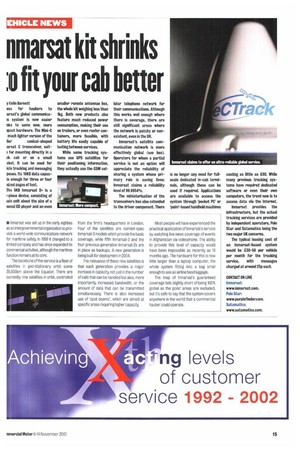nmarsat kit shrinks :o fit your cab better
Page 15

If you've noticed an error in this article please click here to report it so we can fix it.
y Colin Barnett ess for hauliers to arsat's global communicais system is now easier nks to some new, more mact hardware. The Mini-C much lighter version of the
her conical-shaped larsat C transceiver, suitfor' mounting directly in a ck cab or on a small cket. It can be used for icle tracking and messaging poses. Its 10KB data capacis enough for three or four sized pages of text.
The BKB Inmarsat D. is a 1-piece device, consisting of lain unit about the size of a serial CD player and an even
smaller remote antennae box, the whole kit weighing less than lkg. Both new products also feature much reduced power consumption, making their use on trailers, or even reefer containers, more feasible, with battery life easily capable of lasting between services.
While some tracking systems use GPS satellites for their positioning information, they actually use the GSM cel
briar telephone network for their communications. Although this works well enough where there is coverage, there are still significant areas where the network is patchy or nonexistent, even in the UK.
Inmarsat's satellite communication network is more effectively global (see box). Operators for whom a partial service Is not an option will appreciate the reliability of sharing a system whose primary role is saving lives: Inmarsat claims a reliability level of 99.9054%.
The miniaturisation of the transceivers has also extended to the driver component. There
is no longer any need for fullscale dedicated in-cab terminals, although these can be used If required. Applications are available to access the system through 'pocket PC' or 'paid-based handheld machines
costing as little as £80. While many previous tracking systems have required dedicated software or even their own computers, the trend now is to access data via the Internet.
Inmarsat provides the infrastructure, but the actual tracking services are provided by independent operators, Pole Star and Satamatics being the two major UK concerns.
The typical leasing cost of an Inmarsat-based system would be £3040 per vehicle per month for the tracking service, with messages charged at around 25p each.
CONTACT ON LINE Inmarsat: www.inmarsat.com. Pole Star: www.purplefinder.com. Satainatics: ivivw.satamatles.cam.












































































































































